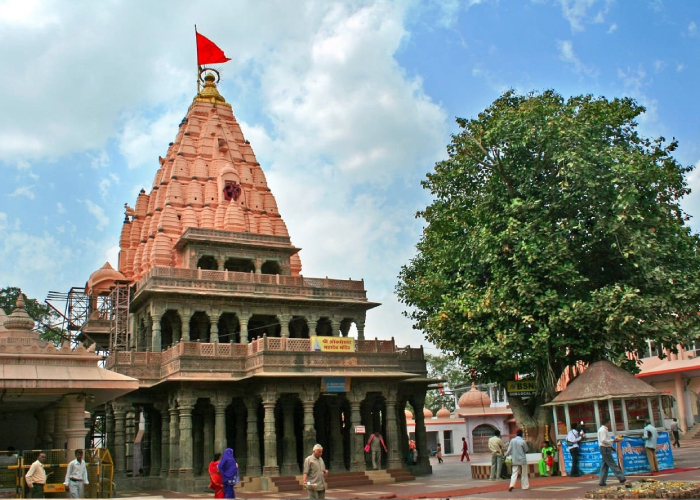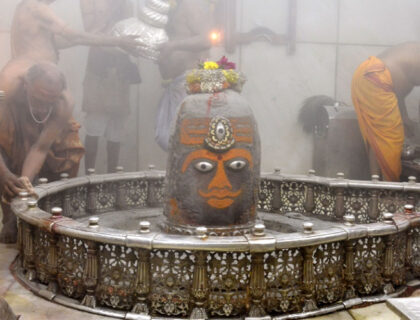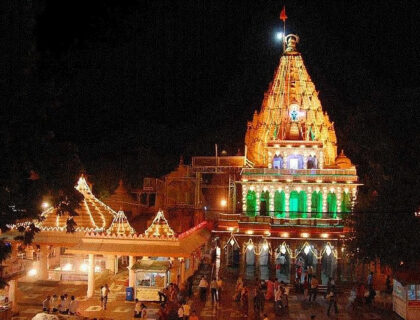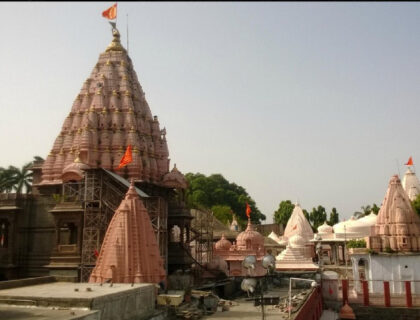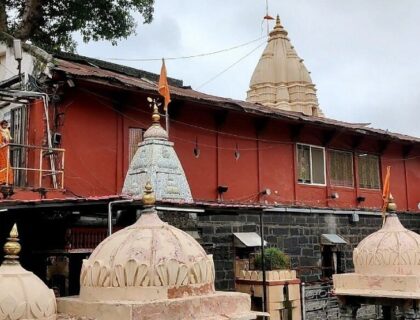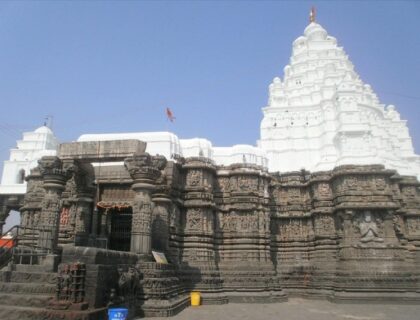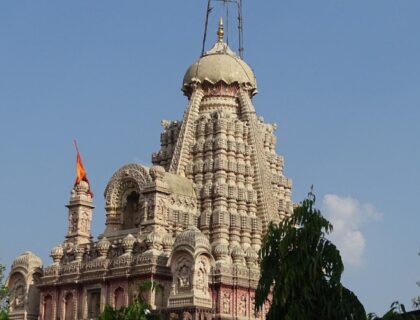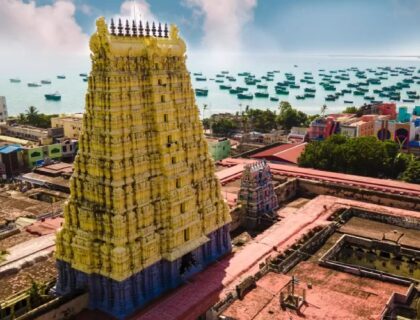Mahakaleshwar Jyotirling
The Mahakaleshwar Jyotirling Temple is a Hindu temple dedicated to Lord Shiva and is one of the twelve Jyotirlingas shrines located in Ujjain City Of Madhya Pradesh. This temple is said to be Lord Shiva’s most sacred shrine. It is located in the Indian state of Madhya Pradesh, in the ancient city of Ujjain. The temple is located on the banks of the Holy Shipra River.
Unlike other ritually established images and lingams imbued with mantra-shakti, the presiding deity, Shiva in the form of a lingam, is thought to be Swayambhu because it draws power (Shakti) from within itself.
The Mahakaleshwar Jyotirling Temple was built in the Maratha, Bhumija, and Chalukya architectural styles. It is divided into five levels, one of which is underground. Lord Shiva’s consort, Goddess Parvati (to the north), his sons, Ganesha (to the west) and Kartikeya (to the east), and his mount, Nandi (to the south) are all depicted.
Mahakaleshwar Jyotirling Temple Story
According to the Puranas, Ujjain was known as Avantika and was famous for its beauty as well as its status as a devotional epicentre. It was also one of the most important cities for students to study holy scriptures. According to legend, there was a ruler of Ujjain named Chandrasena who was a devout devotee of Shiva and constantly worshipped him. One day, a farmer boy named Shrikhar was walking through the palace grounds when he heard the King chant Shiva’s name and rushed to the temple to join him in prayer.

However, the guards forcibly removed him and sent him to the outskirts of the city near the river Kshipra. Around this time, rivals of Ujjain, primarily King Ripudamana and King Singhaditya of neighbouring kingdoms, decided to attack the Kingdom and seize its treasures. When Shrikhar heard this, he began to pray, and the news reached a priest named Vridhi. He was shocked to learn this and, at the urging of his sons, began to pray to Shiva at the Kshipra River. The Kings chose to attack and were successful; they plundered the city and attacked all Shiva devotees with the help of the powerful demon Dushan, who was blessed by Brahma with the ability to be invisible.
When Shiva heard His helpless devotees’ cries, He appeared in Mahakala form and destroyed King Chandrasena’s enemies. At the request of his devotees Shrikhar and Vridhi, Shiva agreed to reside in the city and become the Kingdom’s chief deity, guarding it against its enemies and protecting all His devotees. Shiva lived in His light form as Mahakala in a Lingam formed by Shiva and his consort, Parvati, from that day. Shiva also bestowed blessings on his devotees, declaring that those who worshipped Him in this form would be immune to death and disease.
Mahakaleshwar Jyotirling Temple History
During Iltutmish’s raid on Ujjain in 1234–35, the Mahakaleshwar Jyotirling temple complex was destroyed. The Jyotirlinga was dismantled and thought to have been thrown into a nearby “Kotiteerth Kunda,” which is a pond next to the temple, with the Jaladhara “(a structure that supports the Lingam) stealing during the invasion.
Following his appointment by Baji Rao I to collect taxes in the Malwa region, the Maratha general Ranoji Shinde constructed the current structure in 1734 CE. Other Shinde dynasty members, such as Mahadji Shinde (1730–12 February 1794) and the wife of Daulat Rao Shinde, Baiza Bai, carried out additional development and management. 1827–1863). This temple hosted major Gwalior State events from Jayajirao Shinde’s time up until 1886.
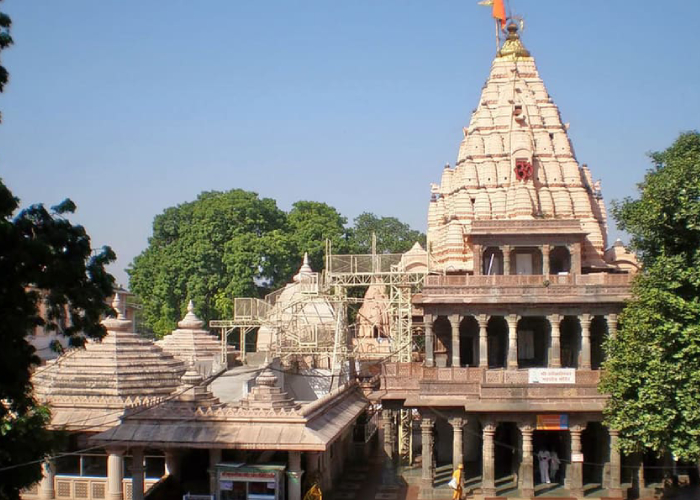
In the fourth decade of the 18th century, Ujjain saw the establishment of the Maratha Empire regime. Peshwa Bajirao-I delegated the administration of Ujjain to his devoted commander Ranoji Shinde. Ranoji’s Diwan was Sukhatanakar Ramchandra Baba Shenavi, who was extremely wealthy and made the decision to invest his wealth for religious purposes. In this regard, between the fourth and fifth decades of the 18th century, he rebuilt the Mahakaleshwar Temple. The municipal corporation of Ujjain took over from the Mahakaleshwar Dev Sthan Trust following India’s independence in 1947. It is currently managed by the collectorate office of the Ujjain district.
Mahakaleshwar Jyotirling Temple Architecture
The Mahakaleshwar Jyotirling Temple, built in the fourth and fifth centuries A.D., combines Bhumija, Maratha, and Chalukya architectural styles. In addition to the Mahakal temple, there are three other temples on the property: one for Lord Ganesha, one for Goddess Parvati, and one for Nagchandreshwar. The Nagchandreshwar temple is only open to pilgrims and visitors during the Nag Panchami festival. Shiva devotees have been drawn to the Mahakal temple in Ujjain for its splendour and structure since ancient times.

The Mahakaleshwar idol is known as Dakshina Mukhi, which means it faces south. This is a unique feature preserved by the tantric shivnetra tradition and found only among the 12 Jyotirlingas in Mahakaleshwar. In the sanctum above the Mahakal shrine, the idol of Omkareshwar Mahadev is consecrated. The images of Ganesh, Parvati, and Karttikeya are installed in the sanctum sanctorum to the west, north, and east. Nandi, Shiva’s vehicle, is depicted to the south. On Nag Panchami, the idol of Nagchandreshwar on the third floor is only open for darshan. The temple has five levels, one of which is underground.

The Mahakaleshwar Jyotirling Temple is set in a large courtyard surrounded by massive walls near a lake. The spire, or shikhara, is adorned with sculptural finery. The path to the underground sanctum is lit by brass lamps. Unlike all other shrines, it is believed that prasada (holy offering) offered to the deity here can be re-offered.
Facts About Mahakaleshwar Jyotirling Temple
- Mahakaleshwar Jyotirling has its own source of power because it is a self-manifested Jyotirling. It, like the other lingas and moorthies (statues), does not need the mantra Shakti to be powerful.
- Dakshinamukhi is the only jyotirlinga that faces south. The other jyotirlingas all face east. This is due to the belief that the direction of death is south.
- Lord Shiva facing south represents his mastery over death. In fact, people worship Mahakaleshwar to avoid death and live a long life.
- Nagchadreshwar is open to the public only once a year, on Nag Panchami. On all other days, it is closed.
- Bhasma aarti (ash offering) is a well-known ritual in this region. As pure, non-dual, imperishable, and unchangeable as ash, so is the Lord.
- The shrine is also revered as one of the 18 Maha Shakti Peetham.
- On the day of Maha Shivaratri, a huge fair is held near the temple, and worship goes on through the night.
- Recently, the massive corridor, which is over 900 metres long, one of the longest of its kind in India was inaugurated by PM Narendra Modi with the help of Madhya Pradesh Cm Shivraj Singh.
- The Mahakal Corridor is centred on the historic Rudrasagar Lake. The corridor is lined with 200 Shiva idols and many other gods and goddesses idols.
Festivals In Mahakaleshwar Jyotirling Temple
- Nitya Yatra: During this festival, the main Yatri bathes in holy Sipra and then seeks blessings from the idols of goddess Mahakalesvara, Harasiddhi, Nagachandresvara, goddess Avantika, Kotesvara, and Agastyesvara.
- Sawari: Every Monday, the sacred procession passes through the streets of Ujjain. This procession is dedicated to Lord Shiva, and the one held during the Bhadrapada fortnight is celebrated with great zeal.
- Mahashivratri: The day before the Amavasya (new moon) of each lunar month is called Shivarathri. Mahashivaratri is the most prominent festival celebrated here.
- Deepawali: This festival is celebrated on Amavasya of Karthik month of the Hindu calendar.
How to Reach Mahakaleshwar Jyotirling Temple
Mahakaleshwar Jyotirling Temple is located in the Indian state of Madhya Pradesh and is reachable via domestic flights from any location in the country. Ujjain Junction is easily reachable from all Indian cities, and both long-distance and short-distance trains run to and from the city’s major railway station.
By Air: The nearest airport is Ahilya Devi Airport in Indore which is 60 km from the temple.
By Rail: Ujjain Junction is well-connected with all Indian cities, and both long and short-distance trains ply to and from the city’s main railway station. The temple is just 1.4 Km From Ujjain Railway Station.
By Raod: Mahakaleshwar can be easily accessed from the nearby cities by bus. Frequent government and private buses are running from the capital Indore throughout the day. The Ujjain bus stand is just 1.4 km from the temple.
Also Read – Kashi Vishwanath Jyotirling Temple
Location
Facilities
- Drinking Water
- Pooja Item Shops
- Prasad Shops
- Restaurants Nearby
- Resting Room

